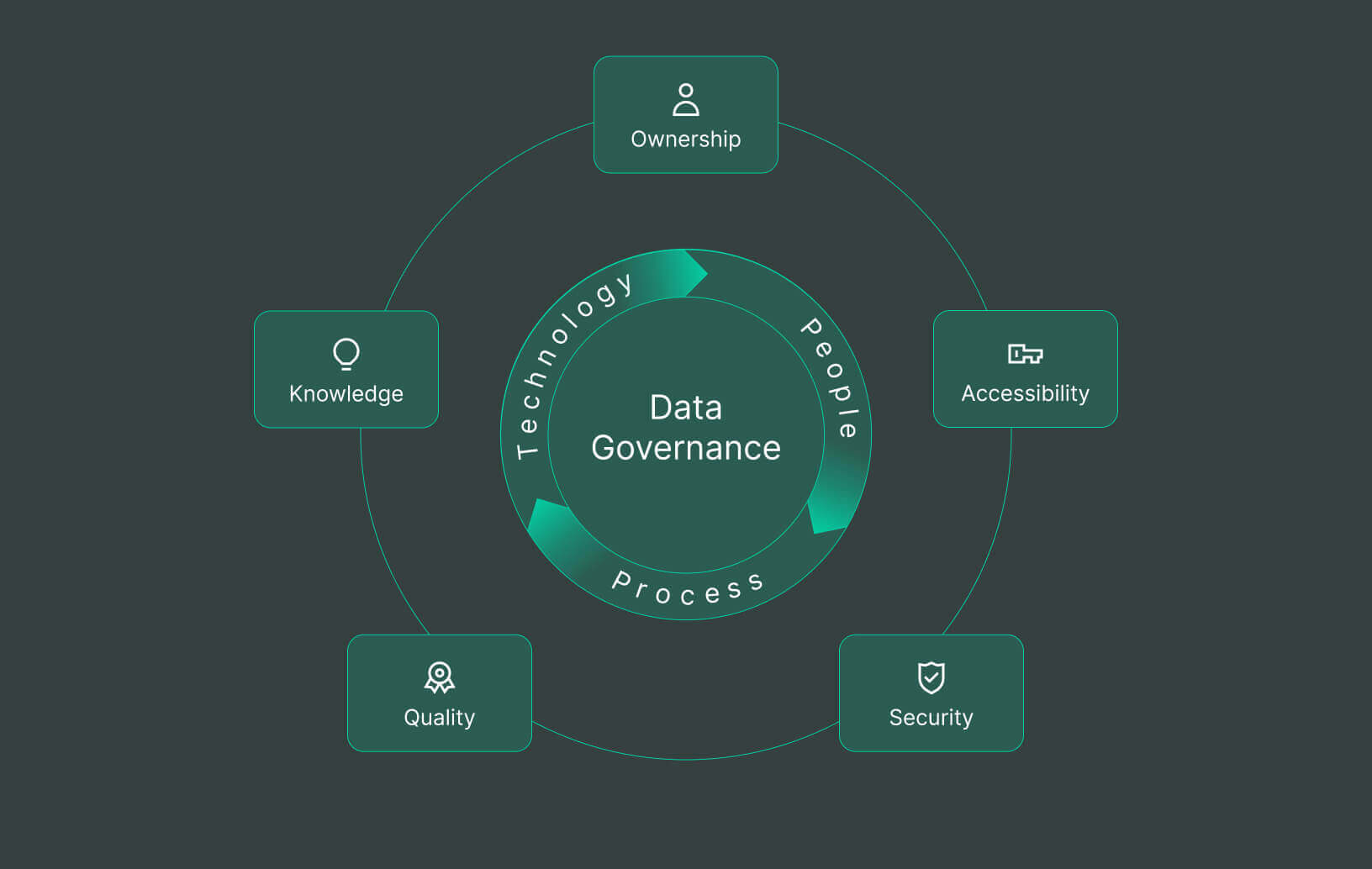
What is Data Governance?
This is an essential process for effectively managing data within enterprise data systems. It encompasses various aspects such as availability, usability, integrity, and security while adhering to internal data standards and policies. By implementing data governance, organizations can ensure that their data remains consistent, trustworthy, and protected from misuse. This becomes particularly crucial in light of evolving data privacy regulations and the growing reliance on data analytics to enhance operations and drive informed business decisions.
Why is data governance important for businesses and companies?
Data governance helps companies manage their data effectively. Below are some key reasons why it is crucial for companies:
Risks of poor data governance
When data management is neglected, it can spell trouble for organizations. Inconsistent and inaccurate data becomes the norm, eroding trust in the information at hand. This, in turn, hampers decision-making processes, leading to misguided choices and potentially costly operational inefficiencies.
The repercussions don’t stop there—poor data governance can tarnish a company’s reputation, causing lasting damage. Compliance concerns further compound the issue, as non-compliance can result in legal entanglements and hefty fines.
Benefits of effective data governance
A robust data governance strategy empowers businesses and organizations to elevate their data quality, accuracy, and consistency. This, in turn, translates into enhanced decision-making capabilities, reduced operational expenses, and heightened customer satisfaction.
Impact of data governance on compliance and regulations
It is of utmost importance for companies, as it is a safeguard for adhering to stringent data privacy laws and regulations. Notably, legislation like the General Data Protection Regulation (GDPR) and the California Consumer Privacy Act (CCPA) necessitate organizations to handle personal data with utmost care.
What is data governance used for?
Data governance is used for various purposes in organizations, some of which are:
Improving data quality
It plays a crucial role in maintaining the integrity and trustworthiness of data within an organization. By implementing well-defined data standards, robust policies, and adequate data quality controls, businesses can significantly enhance the overall quality of their data.
This, in turn, empowers decision-makers with accurate and reliable information, leading to better strategic choices, streamlined operations, and improved customer satisfaction. For instance, implementing data governance practices in a financial institution allows for standardized data entry processes, meticulous data validation, and the elimination of duplicate records.
Ensuring compliance with regulations
An effective data governance program is essential for organizations to comply with data privacy regulations, industry standards, and legal requirements. It helps establish strong data protection measures, access controls, and retention policies. In healthcare, data governance program is crucial for adhering to regulations like HIPAA.
Facilitating data sharing and collaboration
The Data governance program facilitates data sharing and collaboration within and between organizations. By implementing its practices, such as defining data sharing policies, access permissions, and data usage agreements, a research data governance institute can foster effective collaboration among researchers from diverse disciplines. These practices ensure that data is shared efficiently and securely while upholding data privacy and security standards.
Managing data security and privacy
Data governance is dedicated to safeguarding data assets and mitigating the risks of unauthorized access, breaches, and misuse. Organizations can protect sensitive information effectively by implementing robust security measures, data classification frameworks, and access controls. In the case of an e-commerce company, data governance best practices are essential in securing customer payment information. By employing encryption technologies, implementing strict authentication protocols, and conducting regular security audits, the company can fortify its defenses against data breaches and fraud, ensuring the safety and trust of its customers.
Reducing data-related risks
Data governance identifies and mitigates risks associated with master data management, such as data loss, data breaches, and data inconsistencies. It establishes procedures and controls to minimize these risks and ensure data integrity.
A manufacturing company implements data governance practices to track and manage product data throughout its lifecycle, reducing the risk of inaccurate or outdated product information being used in production processes and preventing costly errors.
Optimizing data management
Data governance plays a crucial role in optimizing data management processes for organizations. Organizations can streamline their data integration, storage, retrieval, and archiving governance activities by establishing guidelines for data lifecycle management, implementing data governance frameworks, and standardizing data management practices.
What are the benefits of data governance?
Data governance offers several organizational benefits. Here are some key benefits explained:
Improved data quality
Data governance is instrumental in enhancing the quality of data within organizations. By establishing data standards, validation rules, and quality controls, businesses can ensure that their data is accurate, consistent, and reliable. This improved data quality facilitates better decision-making, boosts operational efficiency, and fosters greater customer satisfaction. With robust data governance practices in place, organizations can optimize their processes and fully leverage the value of their data assets.
Enhanced decision-making
With effective data governance, businesses have access to reliable and trustworthy data. This enables leaders and decision-makers to make informed and data-driven decisions. Accurate and timely data helps identify trends, patterns, and insights, leading to better data governance strategy, planning, and improved business outcomes.
Increased operational efficiency
Data governance streamlines data management processes by defining roles, responsibilities, and processes for data handling. It reduces data duplication, ensures data consistency, and improves data integration. These streamlined processes increase operational efficiency, reduce costs, and improve productivity.
Compliance with regulations
Data governance helps businesses comply with data privacy regulations and industry standards. By establishing data protection measures, access controls, and data retention policies, businesses ensure that they handle data in a compliant manner. Compliance mitigates legal and financial risks and fosters trust and credibility among customers and partners.
Data security and privacy
Data security and privacy are also enhanced through data governance practices. By defining security measures, access controls, and encryption protocols, businesses can protect sensitive data, safeguarding against unauthorized access, breaches, and misuse.
Risk mitigation
Data governance identifies and mitigates risks associated with data management. By establishing procedures, controls, and governance frameworks, businesses minimize the risks of data loss, breaches, and inconsistencies. Proactive risk management protects the organization’s reputation, helps avoid costly mistakes, and ensures business continuity.
Improved customer experience
Data governance ensures businesses have a holistic view of customer data across different touchpoints. This enables a personalized and seamless customer experience. Businesses can deliver targeted marketing campaigns, personalized offers, and exceptional customer service by leveraging clean and accurate data.
Increased data value
Data governance maximizes the value of data as a strategic asset. Businesses can leverage data governance strategy effectively across various functions and departments by establishing data ownership, stewardship, and usage policies. This drives innovation, identifies new opportunities, and unlocks the full potential of data to gain a competitive edge.
Data governance models
Data governance models define organizations' structure and approach to govern their data. These models determine how decision-making authority, responsibilities, and control over data are distributed within an organization. Here are explanations of some common data governance models:
Centralized model
In the centralized model, data governance is managed by a central authority or a dedicated data governance team responsible for establishing and enforcing data policies and standards across the organization. This model ensures consistency and control over data management practices, with clear accountability and decision-making power in the central governing body.
Decentralized model
In the decentralized model, data governance responsibilities are distributed among different departments or business units within the organization. Each department or unit has autonomy over its processes and policies. This model allows for flexibility and specialization, as departments can tailor data governance practices to their specific needs.
Hybrid model
The hybrid model combines elements of both centralized and decentralized approaches. In this model, certain aspects of data governance, such as defining enterprise-wide policies and standards, are centralized. In contrast, operational data governance responsibilities are delegated to individual departments or business units. This model strikes a balance between consistency and flexibility, enabling a unified approach while catering to department-specific requirements.
Federated model
The federated model establishes a network of autonomous data governance domains or units across the organization. Each domain has its team and policies aligning with overarching enterprise-wide principles. Domains collaborate to share best practices and coordinate data governance efforts while maintaining independence. This model promotes a balance between centralized control and localized decision-making.
Collaborative model
The collaborative model emphasizes cross-functional collaboration and cooperation in data governance. It involves establishing a collaborative framework where representatives from different business functions, departments, and data stakeholders work together to define and enforce data policies, standards, and practices. This model fosters a shared understanding of data governance goals, promotes transparency, and leverages the expertise of diverse stakeholders.
Key components of data governance
Key components of data governance that are important for companies include:
Data policies and standards
Data governance defines data rules and standards that specify how data inside an organization should be managed, kept, accessed, and shared. These rules establish uniformity and guide data processing, assuring data accuracy, reliability, and regulatory compliance. Clear data rules and standards allow businesses to make educated choices based on reliable data.
Data quality and management
Data governance is concerned with preserving data quality throughout its lifespan. It entails putting procedures, controls, and technologies in place to assure data correctness, completeness, consistency, and timeliness. Companies may reduce mistakes, increase operational efficiency, and improve decision-making by imposing their requirements.
Data security and privacy
Data governance addresses data security and privacy concerns by implementing appropriate measures to protect sensitive information from unauthorized access, breaches, and misuse. It involves defining access controls, data encryption protocols, and data masking techniques to safeguard data assets. Compliance with data privacy regulations is essential to maintain customer trust and avoid legal and reputational risks.
Data architecture and integration
This includes creating data models, structures, and strategies for integrating data across systems and applications. The objective is to guarantee that data flows smoothly and seamlessly, allowing businesses to successfully analyze, report, and make educated choices. Organizations may enhance the value and usefulness of their data resources by creating effective data architecture and integration procedures.
Data governance processes
Data governance processes are the systematic activities and procedures involved in managing and governing data within an organization. Each process ensures data consistency, accuracy, security, and compliance. Here’s an explanation of each process and its importance:
1. Data quality management
Data quality management focuses on maintaining and improving the quality of data. It involves defining standards, conducting data profiling, implementing data cleansing and validation processes, and monitoring data quality metrics. This process ensures that data is accurate, complete, consistent, and relevant, enabling better decision-making and operational efficiency.
2. Data stewardship
Data stewardship assigns ownership and accountability for data assets to designated individuals or teams known as data stewards. Data stewards are responsible for managing and maintaining data, ensuring compliance with data policies and standards, resolving data issues, and acting as subject-matter experts. Data stewardship helps establish clear data governance roles, responsibilities, and decision-making authority.
3. Metadata management
Metadata management focuses on capturing and managing metadata, which provides information about data characteristics, structure, and usage. It includes defining metadata standards, establishing metadata repositories, and ensuring metadata consistency and accuracy. Metadata management enables efficient data discovery, understanding, and usage, facilitating effective data governance and decision-making.
4. Data security and privacy
Data security and privacy processes are essential to protect sensitive and confidential data from unauthorized access, breaches, and misuse. This involves defining data access controls, encryption methods, data masking, data anonymization, and establishing security policies and procedures. Data security and privacy measures safeguard data assets, maintain compliance with regulations, and protect the organization’s reputation.
5. Data lifecycle management
Data lifecycle management encompasses the processes and procedures for managing data throughout its lifecycle, from creation to archival or deletion. It includes data classification, retention policies, archiving, and disposal. Effective data lifecycle management ensures data availability, integrity, and compliance while optimizing storage resources and minimizing risks associated with outdated or unnecessary data.
6. Data integration and interoperability
Data integration and interoperability processes enable data governance seamlessly across various systems, applications, and platforms. It involves establishing data integration frameworks, mapping, transformation, and synchronization. Data integration and interoperability ensure data consistency, improve data accuracy, and enable organizations to leverage data from diverse sources for better decision-making.
7. Regulatory compliance
Regulatory compliance processes ensure data governance practices align with relevant laws, regulations, and industry standards. It involves monitoring and adhering to data privacy regulations, such as GDPR or CCPA, data protection requirements, and industry-specific compliance obligations. Compliance with regulations safeguards data privacy, mitigates legal risks, and fosters trust among customers and partners.
8. Change management
Change management processes address the organizational aspects of data governance tools, including communication, training, and adopting data governance practices. It involves managing change resistance, ensuring stakeholder buy-in, and fostering a culture of data governance within the organization. Change management helps drive successful implementation and continuous improvement of data governance initiatives.

In this article, we’ll talk about:
- Why is data governance important for businesses and companies?
- What is data governance used for?
- What are the benefits of data governance?
- Data governance models
- Key components of data governance
- Data governance processes
- Who is responsible for data governance?
- What are some of the biggest data governance challenges?
- Opportunities for data governance in the future
- Data governance best practices
- Final words
Who is responsible for data governance?
In data governance, various roles and stakeholders are responsible for ensuring an organization’s effective management and governance of data. These roles collaborate to establish and enforce data policies, standards, and practices. Here are explanations of some key roles:
Data owners
Data operators are individuals or business units responsible for specific data sets' overall accountability and governance. They can decide on data access, usage, and protection. Data owners define data requirements, establish data quality expectations, and ensure compliance with regulations and policies. They collaborate with other stakeholders to ensure data is properly managed throughout its lifecycle.
Data stewards
Data stewards manage and maintain data quality, integrity, and security within specific domains or datasets. They work closely with data owners, users, and IT teams to implement data governance practices. Data stewards perform tasks such as data profiling, data cleansing, metadata management, resolving data issues, and providing guidance on data usage. They act as subject-matter experts and enforce data governance policies within their areas of responsibility.
Data custodians
Data custodians are individuals or teams responsible for the technical implementation and management of data assets. They handle the operational aspects of data governance, including data storage, data backups, data security measures, and data system administration. Data custodians ensure data is available, protected, and accessible according to the defined data governance policies and requirements.
Data governance committee
The data governance committee comprises representatives from various business functions, IT teams, and data stakeholders. The committee acts as the governing body for the data governance initiative. It sets the strategic direction, establishes data governance policies, and makes decisions regarding data management, privacy, security, and compliance. The committee oversees the implementation and enforcement of data governance practices and ensures alignment with organizational objectives.
What are some of the biggest data governance challenges?
Implementing and maintaining effective data governance can pose several challenges for organizations. These challenges can hinder the successful execution of data governance initiatives and impact the organization’s ability to realize the full potential of its data assets. Here are some of the significant data governance challenges:
Organizational challenges
Organizational challenges encompass issues related to organizational structure, culture, and collaboration. These challenges include siloed data management practices, lack of cross-functional communication and coordination, resistance to change, and difficulty in establishing clear roles and responsibilities for data governance. Overcoming these challenges requires strong leadership, stakeholder buy-in, and a cultural shift toward a data-driven mindset.
Inconsistent data quality
Ensuring consistent data quality is a major challenge in data governance. Organizations often struggle with data inconsistencies, data errors, duplication, and incomplete or outdated information. Poor data quality hampers decision-making, affects operational efficiency, and undermines trust in data. Overcoming this challenge requires implementing data quality management processes, data cleansing techniques, and establishing standards.
Understanding the value of data
Many organizations struggle to understand and appreciate their data assets' value fully. This challenge arises from a lack of awareness about the potential insights and opportunities. Organizations need to invest in data literacy initiatives, educate stakeholders about the benefits of data-driven decision-making, and demonstrate tangible outcomes derived from effective data governance best practices.
Poor data management
Data management issues, including fragmented data systems, a lack of defined procedures, and insufficient data documentation, could hinder data governance attempts. Organizations confront data integration, access, and discovery challenges without adequate data management strategies. These issues may be addressed using strong data management frameworks, data governance tools, and systems.
Lack of sponsorship
A fundamental challenge in data governance is strong executive sponsorship and support. Data governance efforts may lack the essential resources, financing, and organizational priorities if leaders do not support them. Inadequate involvement from stakeholders, restricted adoption of data governance standards, and problems pushing organizational change may all result from a lack of sponsorship.
Opportunities for data governance in the future
In the future, data governance framework is expected to play a crucial role in managing and maximizing the value of data. Here are some potential opportunities for data governance in the future:
Data privacy and security
As data privacy regulations become more stringent worldwide, organizations need robust data governance frameworks to ensure compliance and protect sensitive information. Data governance office can help establish data protection policies, implement security measures, and monitor data access and usage.
Data quality and integrity
With the exponential growth of data, ensuring data quality and integrity will be essential. It can provide guidelines and processes for data validation, standardization, and cleansing, thereby improving the accuracy and reliability of data.
AI and machine learning
As organizations increasingly rely on artificial intelligence and machine learning algorithms, data governance office becomes critical to ensure data’s ethical and responsible use. Governance frameworks can address biases, transparency, and accountability in AI systems, fostering trust and responsible decision-making.
Data monetization
Data is considered a valuable asset, and organizations are exploring ways to monetize their data assets. It can help identify and leverage opportunities for data monetization while ensuring compliance with regulations and ethical considerations.
Data collaboration and sharing
In an interconnected world, data sharing and collaboration across organizations can unlock significant value. Data governance frameworks can facilitate data sharing agreements, establish data usage policies, and ensure proper data stewardship, enabling secure and trusted data collaboration.
Emerging technologies
As new technologies such as blockchain, edge computing, and the Internet of Things (IoT) gain prominence, data governance will need to adapt and evolve. Governance frameworks can address these technologies' unique challenges and opportunities, ensuring proper data management and control.
Data governance best practices
Data governance is essential for organizations to manage and govern their data assets effectively. By implementing best practices in data governance, organizations can ensure data integrity, quality, and security while maximizing the value derived from data. Here are some key best practices:
Clearly define roles and responsibilities
Establish clear roles and responsibilities for data governance, including data stewards, data owners, and a data governance committee. Assign accountability for data-related tasks and decision-making to ensure effective governance.
Develop a framework
Create a comprehensive data governance framework that outlines the principles, policies, and processes for data management. This framework should address data quality, privacy, security, access controls, data lifecycle management, and compliance.
Establish data standards and policies
Define data standards, naming conventions, data definitions, and metadata management practices. Develop policies and procedures outlining data collection, storage, sharing, and usage guidelines.
Implement data quality management
Adopting effective procedures for monitoring, reviewing, and improving data quality is critical to ensuring data entity. This entails developing precise measures to evaluate data quality and performing frequent reviews to monitor and maintain correctness.
Ensure Data security and privacy
Implement robust security measures to protect data from unauthorized access, breaches, and data loss. Develop data classification and access control mechanisms. Comply with relevant data privacy regulations and establish data anonymization or pseudonymization procedures when necessary.
Final words
Data governance is crucial in managing and governing data within organizations. It ensures data consistency, accuracy, security, and compliance with regulations. By implementing effective data governance practices, businesses can unlock several benefits, including improved data quality, enhanced decision-making, reduced risks, and optimized data management processes.
Frequently asked questions (FAQ)
What is a simple example of data governance?
What is a simple example of data governance?
The purpose of BI dashboards is to extract insights from data visualizations that help executives in decision-making. Businesses use BI dashboards for two significant purposes Regular BI Reporting and Ad hoc reporting. The end goal is data-driven decision-making.
What is the difference between data governance and data management?
What is the difference between data governance and data management?
What are data governance tools?
What are data governance tools?
What is the main goal of data governance?
What is the main goal of data governance?
Get started for free



